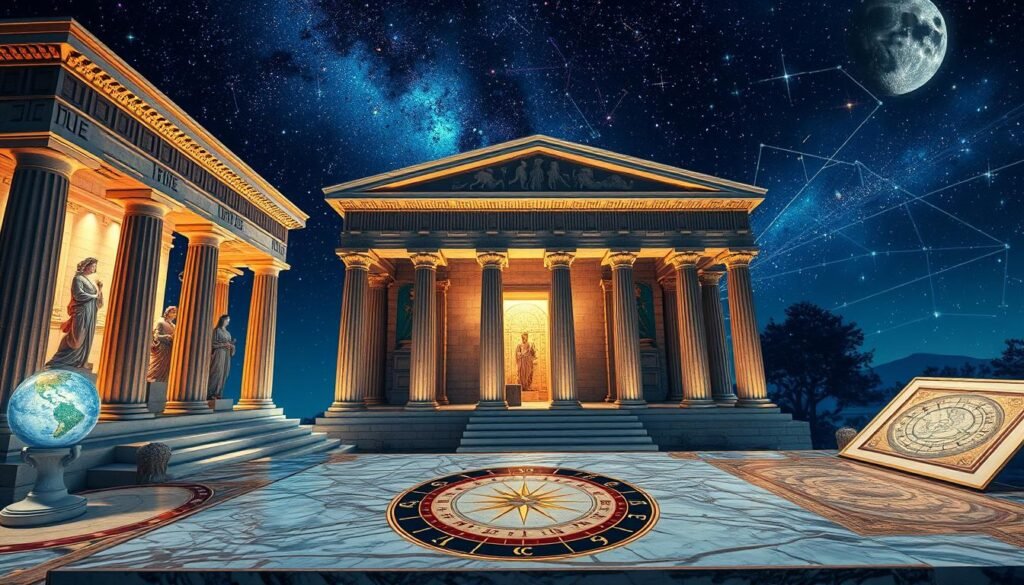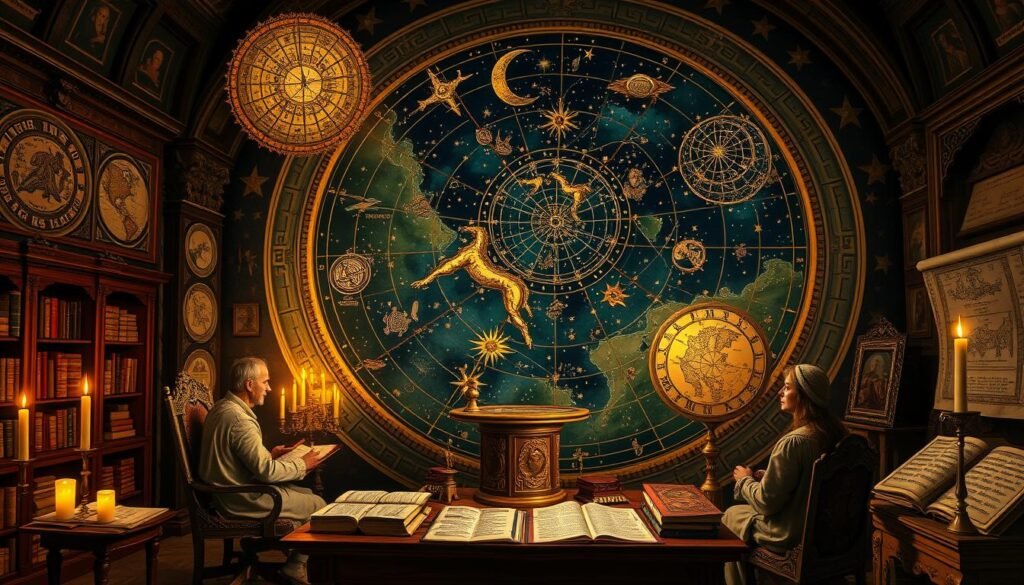Did you know astrology has been fascinating humans for over 5,000 years? Before modern science, ancient cultures worldwide looked up at the stars. They sought to understand the mysteries of the sky. From Mesopotamian star watchers to Egyptian astronomers, astrology’s story is deeply rooted in human history.
In this journey through astrology’s history, we’ll uncover its ancient roots. We’ll see how it evolved from its divine origins to its lasting impact on culture and society. Get ready to travel back in time. The night sky was once a canvas of stars, filled with celestial stories waiting to be discovered.
Key Takeaways
- Astrology has a rich history dating back over 5,000 years, rooted in ancient civilizations’ fascination with the celestial realm.
- Early cultures, from Mesopotamia to Egypt and China, developed sophisticated systems of celestial observation and interpretation.
- Astrology evolved from divine messages to a cultural practice, shaping beliefs and influencing decision-making across various societies.
- The development of the zodiac and the incorporation of planetary rulers and house systems were key milestones in the history of astrological thought.
- The contributions of Greek, Roman, and medieval scholars helped solidify astrology’s place in the intellectual and cultural landscape.
Ancient Origins: The Birthplace of Celestial Observation
The roots of astrology go back to ancient times. Mesopotamian, Egyptian, and Chinese cultures developed complex ways to watch and understand the stars. These early star watchers set the stage for how we see the universe today.
Mesopotamian Star Watchers
In the land between the Tigris and Euphrates rivers, the Mesopotamians started studying the sky. They tracked the sun, moon, and planets, linking them to life on Earth. Their work in Mesopotamian astronomy mixed divination, math, and myths, influencing astrology later on.
Egyptian Astronomical Records
In Egypt, the Nile River captivated people with its beauty. Egyptian astrology was tied to their faith and the Nile’s cycles. Pharaohs built temples and observatories to follow the stars, helping predict the Nile’s floods and guide farming.
Early Chinese Celestial Studies
In ancient China, people also studied the sky deeply. Chinese celestial studies looked at how the universe and Earth are connected. Court astronomers tracked the sun, moon, and stars to help the Emperor make decisions. This approach helped create China’s rich astrological traditions.
These ancient cultures gave us astrology’s deep understanding of humans and the universe. Their views of the stars still inspire us today.
The History of Astrology: From Divine Messages to Cultural Practice
Astrology has a rich history, changing from a way to understand divine messages to a popular practice worldwide. This journey shows how astrology’s appeal has lasted through time, affecting human societies deeply.
In the past, astrologers were seen as messengers of the gods. They used the stars to guide kings, emperors, and regular people. The divine messages from the stars made astrologers very respected in their cultures.
As time went on, astrology became a big part of everyday life. It went from being a special interest to a respected field that helped with big decisions and planning. In places like ancient Mesopotamia and China’s imperial courts, astrology was key to society, politics, and spirituality.
People love astrology because it helps make sense of the world. Astrologers use the stars to give insights, helping people find their way in life. This gives them confidence and direction.
“Astrology is a language. If you understand this language, the sky speaks to you.”
– Dane Rudhyar, 20th-century astrologer and philosopher
The story of astrology shows how it has grown from a tool for understanding the divine to a global phenomenon. Its journey from divine messages to astrological culture and celestial divination shows our endless curiosity about the universe.
Zodiac Development: Evolution of the Celestial Wheel
The zodiac is a key part of astrology with a long history. It has 12 signs, each with its own traits and meanings. These signs have fascinated people for thousands of years.
Formation of the 12 Signs
The 12 zodiac signs come from ancient cultures like Mesopotamia, Egypt, and China. These people watched the sun, moon, and planets closely. They wanted to know how these bodies affected us. Over time, they created the 12 signs we know today.
Planetary Rulers and Their Significance
Each sign is ruled by a planet, giving it special qualities. These planets help us understand a person’s personality and challenges. Knowing the planets and signs is key to understanding astrology.
House Systems Development
House systems are also important in astrology. They help us see how the stars influence our lives. These 12 houses cover different areas of life. Over time, many have contributed to their development.
| Zodiac Sign | Planetary Ruler | Associated House |
|---|---|---|
| Aries | Mars | 1st House |
| Taurus | Venus | 2nd House |
| Gemini | Mercury | 3rd House |
| Cancer | Moon | 4th House |
| Leo | Sun | 5th House |
| Virgo | Mercury | 6th House |
The zodiac has changed a lot over time. It shows how astrology has always been interesting and important. By learning about the signs, their planets, and houses, we can understand astrology better. It has a big impact on our culture.
Greek and Roman Contributions to Astrological Thought
The ancient Greeks and Romans greatly influenced astrology. Their work, from Hellenistic astrology to Roman horoscopes, has shaped Western astrology. These civilizations left a lasting impact on the study of the stars.
Ptolemy was a key figure in this era. His book, the Tetrabiblos, is a foundational text in Hellenistic astrology. It has guided many astrologers for centuries.
| Key Figures | Contributions |
|---|---|
| Ptolemy | Authored the Tetrabiblos, a seminal work on Hellenistic astrology |
| Vettius Valens | Compiled the Anthology, a comprehensive collection of Hellenistic astrological texts |
| Firmicus Maternus | Wrote the Mathesis, a influential Roman astrological treatise |
Other notable figures, like Vettius Valens and Firmicus Maternus, also made important contributions. Vettius Valens’ Anthology gathered many Hellenistic texts. Firmicus Maternus’ Mathesis is a respected Roman work.
Their ideas and writings still influence astrology today. Their work has helped astrology evolve over time. It continues to fascinate and guide us.

Medieval Astrology: Royal Courts and Religious Influence
The medieval period saw a big comeback in astrology. Islamic scholars and European astrologers were key in its growth. Astrology became important in royal courts and had a tricky relationship with religion.
Astrology in Islamic Golden Age
In the Islamic Golden Age, astrology was highly valued. Scholars made big steps in understanding the stars, mixing science with philosophy and faith. Court astrologers were very respected, helping rulers make big decisions.
European Medieval Practices
In medieval European astrology, it was closely tied to the Catholic Church. Astrologers helped European monarchs with advice on politics and personal life. But, the church had mixed feelings about astrology, with some supporting it and others seeing it as wrong.
Royal Astrologers and Their Impact
- Influential court astrologers in medieval Europe, like John Dee, were key advisors to rulers.
- The bond between Islamic astrology and royal courts led to the creation of observatories and advanced techniques.
- The support of medieval European astrology by royalty and nobility made it very popular and important.
| Astrology in Islamic Golden Age | European Medieval Astrology |
|---|---|
| Respected field of study, integrated with philosophical and religious traditions | Intertwined with the Catholic Church’s teachings, complex stance from acceptance to condemnation |
| Court astrologers highly esteemed, providing guidance to rulers | Influential court astrologers advising rulers and shaping political decisions |
| Establishment of observatories, development of sophisticated techniques | Widespread popularity and cultural significance due to royal and noble patronage |
“Astrology was not merely a pastime for the medieval court, but a crucial tool for navigating the complexities of power and shaping the course of history.”
Renaissance Revival: Astrology Meets Science
The Renaissance saw a big comeback in astrology, blending with the growing scientific revolution. Astrologers and scholars tried to mix their star observations with new astronomy findings. These new discoveries were shaking up old astrological views.
At this time, astrology became very popular. Astrological almanacs and horoscopes were everywhere. Famous figures like Tycho Brahe, a top astronomer, often talked to astrologers. They even used astrological ideas in their work.
The Renaissance astrology movement aimed to merge old star knowledge with the new scientific revolution. People like Galileo Galilei and Johannes Kepler looked into how star observations and astrological views could connect. They wanted to link these two fields together.
But, the push for proof and scientific methods started to make people doubt astrological almanacs and their predictions. This doubt between astrology and science would keep growing over time.
“The stars impel, they do not compel.” – Attributed to Galileo Galilei
The Renaissance was a key time for astrology, facing the challenges of the scientific revolution. This mix of old star watching and new scientific ways would influence both astrology and science’s futures.

Cultural Impact: Astrology Across Different Civilizations
Astrology has been a key part of many ancient cultures. It helped them understand the universe and their role in it. From India’s Vedic traditions to the Maya and Aztecs’ views of the sky, and Africa’s celestial practices, each culture has made a lasting impact on astrology.
Indian Vedic Traditions
The Vedic astrology roots go back thousands of years. It’s deeply connected to ancient India’s sacred texts and spiritual insights. This system combines astronomy with metaphysics, offering guidance on life’s path.
Vedic astrologers use the positions of planets and stars to help people grow and navigate life’s big moments.
Maya and Aztec Cosmic Understanding
The Maya and Aztecs of Mesoamerica were known for their Mayan calendar systems. These calendars were based on their deep understanding of the sky. They tracked the sun, moon, and planets, linking their observations to their culture and religion.
Today, their calendars and knowledge still amaze and inspire many.
African Celestial Practices
In Africa, African celestial traditions have thrived for centuries. They show the continent’s strong bond with the heavens. The Dogon of West Africa and the Maasai in East Africa are examples of this.
These traditions show our universal quest to connect with the stars.
The lasting influence of these astrological traditions highlights the universe’s impact on human history. By exploring each culture’s unique contributions, we appreciate our shared wonder for the stars.
Modern Transformation: 19th and 20th Century Changes
Astrology has changed a lot in the 19th and 20th centuries. It adapted to new science and culture. Modern astrologers now link the stars to our personality, behavior, and feelings.
New discoveries like Uranus, Neptune, and Pluto have added to astrology. This led to new ways of understanding the stars. Astrologers have updated their methods to fit today’s science and needs.
Today, we see many astrological views, from humanistic to evolutionary. Astrology’s lasting appeal shows it can evolve and still connect with people. It helps us grasp the universe and our role in it.

